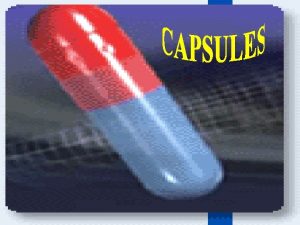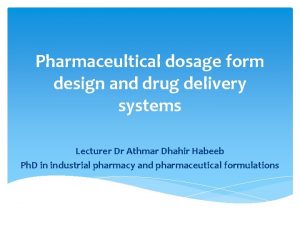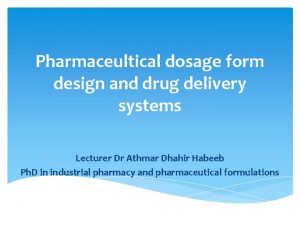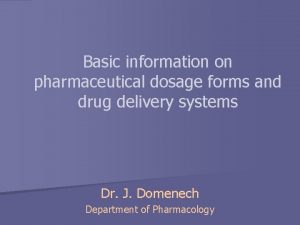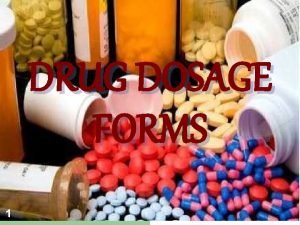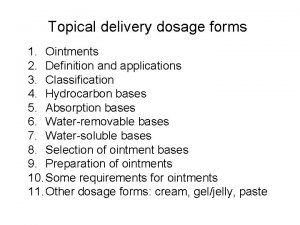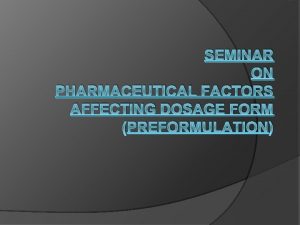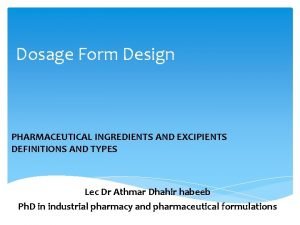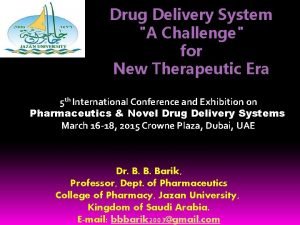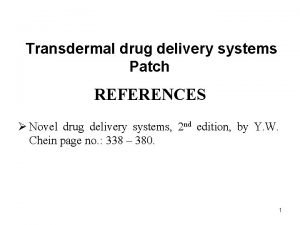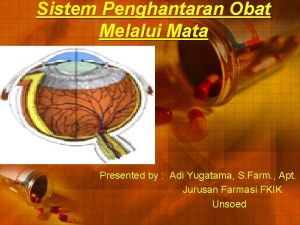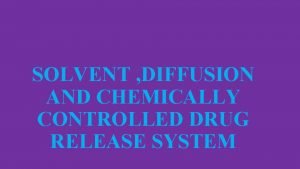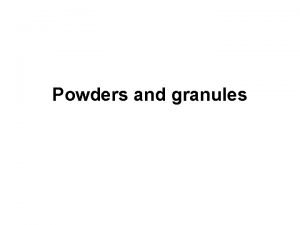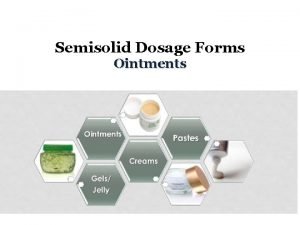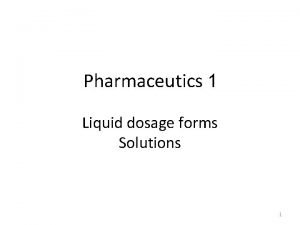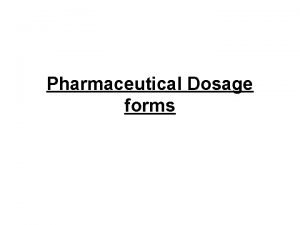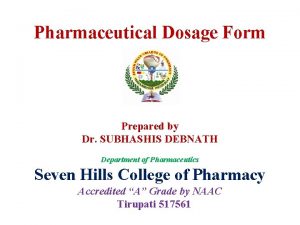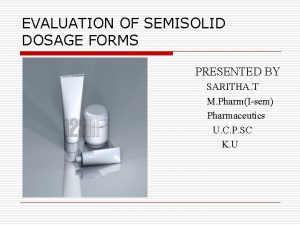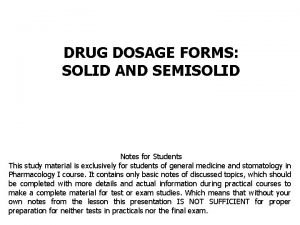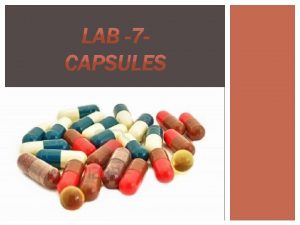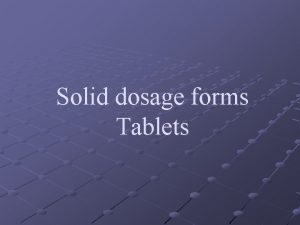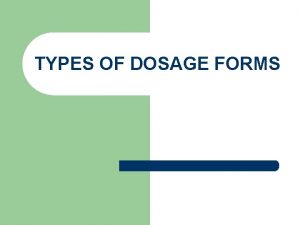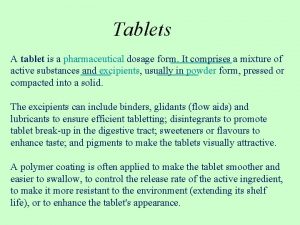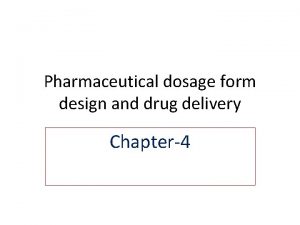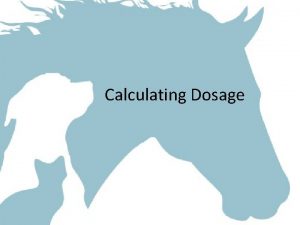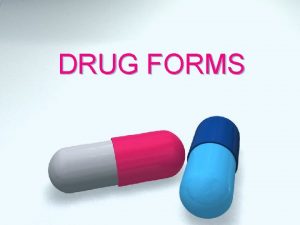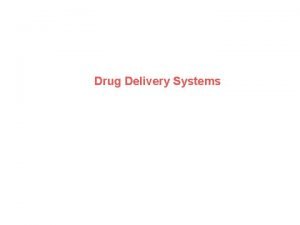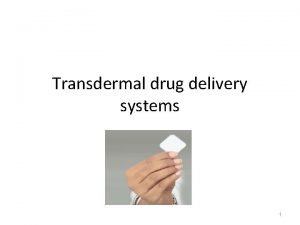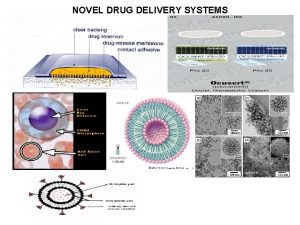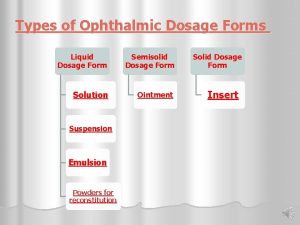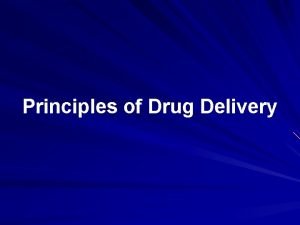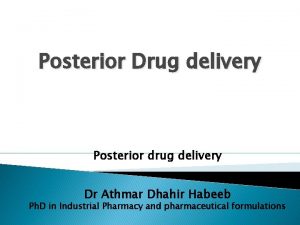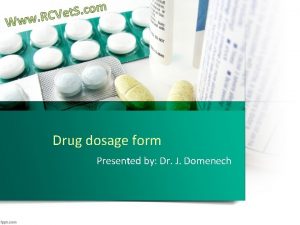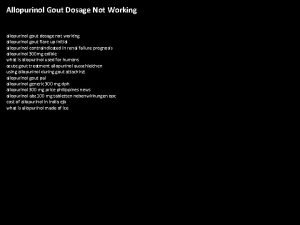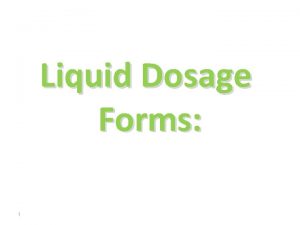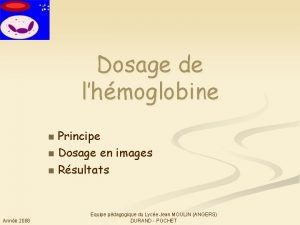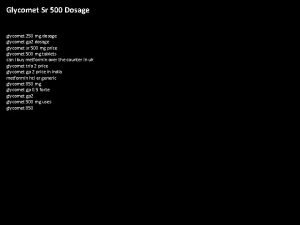Pharmaceultical dosage form design and drug delivery systems




































- Slides: 36

Pharmaceultical dosage form design and drug delivery systems Lecturer Dr Athmar Dhahir Habeeb Ph. D in industrial pharmacy and pharmaceutical formulations

Drug and drug product stability In preformulation work, evaluation of the physical and chemical stability of the drug substance is very important. In these studies drug sample should be of known purity. why? Stability studies in preformulation phase include 1. Solid-state stability of the drug alone 2. Solution phase stability 3. Stability in presence of expected excipients. Initial investigation begins with knowledge of the drug’s chemical structure. Why?

Drug stability: Mechanism of Degradation Chemically, drug substances are …… Each with reactive chemical groups having different susceptibilities to chemical instability Main Degradation pathways Oxidation Hydrolysis

Hydrolysis is a solvolysis process For example, aspirin, or acetylsalicylic acid, combines with a water molecule Why Hydrolysis is the most important single cause of drug decomposition?

Oxidation destroys many drug types, including……. v. Chemically v In inorganic chemistry v. In organic chemistry Oxidation frequently involves free chemical radicals Many of the oxidative change in pharmaceutical preparation have a character of autoxidations. Autoxidations occur spontaneously under initial influence of atmospheric oxygen and proceed slowly at first and then more rapidly.

Drug and product stability: kinetics and shelf life Stability is the extent to which a product retains within specified limits and throughout its period of storage and use (i. e. , its shelf life) the same properties and characteristics that it possessed at the time of its manufacture.

Types of stability Five types of stability concern pharmacists: 1. Chemical: . 2. Physical: . 3. Microbiologic: . 4. Therapeutic: . 5. Toxicologic: .

Chemical stability is important for 1. selecting storage conditions 2. selecting the proper container for dispensing 3. anticipating interactions when mixing drugs and dosage forms. Stability and expiration dating are based on reaction kinetics It is the study of the rate of chemical change and the way this rate is influenced by concentration of reactants, products, and other chemical species and by factors such as solvent, pressure, and temperature.

In considering chemical stability of a pharmaceutical, one must know the reaction order and reaction rate. The reaction order may be the overall order (the sum of the exponents of the concentration terms of the rate expression), or the order with respect to each reactant (the exponent of the individual concentration term in the rate expression). The reaction rate is a description of the drug concentration with respect to time. Most commonly, zero-order and first-order reactions are encountered in pharmacy.

Q 10 Method of Shelf Life Estimation The Q 10 method of shelf life estimation lets the pharmacist estimate shelf life for a product that has been stored or is going to be stored under a different set of conditions.




Enhancing Stability of Drug Products Many pharmaceutical ingredients may be used to prepare the desired dosage form of a drug substances may be used to increase the stability of the drug substance, particularly against hydrolysis and oxidation. In each instance, the added pharmaceutical ingredient must be compatible with and must not detract from the stability of the drug substance.

There are several approaches to the stabilization of pharmaceutical preparations containing drugs subject to hydrolysis. Perhaps the most obvious is the reduction or elimination of water from the pharmaceutical system. solid dosage forms containing water-labile drugs must be protected from humidity in the atmosphere. In liquid preparations water reduced or replaced In certain injectable products, anhydrous vegetable oils may be used as the drug’s solvent

in other liquid drugs by suspending them in a nonaqueous vehicle rather than dissolving them in an aqueous solvent. unstable antibiotic What are the main constituents of a dry powder for reconstitution Together with temperature, p. H is a major determinant of the stability of a drug prone to hydrolytic decomposition. For most hydrolysable drugs, optimum stability is on the acid side, somewhere between p. H 5 and 6. use of buffering agents

oxidation Pharmaceutically, oxidation of a susceptible drug substance is most likely to occur when 1. it is not kept dry in the presence of oxygen 2. it is exposed to light 3. combined with other chemical agents without proper regard to their influence on oxidation. Oxidation of a chemical in pharmaceutical preparation is usually accompanied by 1. an alteration in the color of that preparation. 2. It may also result in precipitation 3. a change in odor.

The oxidative process is diverted and the stability of the drug is preserved by agents called antioxidants How antioxidants work Various antioxidants are employed in pharmacy. 1 - Among those most frequently used in aqueous preparations are sodium sulfite (Na 2 SO 3), sodium bisulfite (Na. HSO 3), sodium metabisulfite (Na 2 S 2 O 5), hypophosphorous acid (H 3 PO 2), and ascorbic acid. 2 - In oleaginous (oily or unctuous) preparations, alphatocopherol, butyl hydroxy anisole, and ascorbyl palmitate find application.

In June 1987, U. S. FDA labeling regulations went into effect requiring a warning about possible allergic-type reactions, including anaphylaxis, in the package insert for prescription drugs to whose final dosage form sulfites have been added. Some but not all epinephrine injections contain sulfites In certain instances, other pharmaceutical additives can inactivate a given antioxidant. In other cases, certain antioxidants can react chemically with the drugs they were intended to stabilize without a noticeable change in the appearance of the preparation.

Because oxygen may adversely affect their stability, certain pharmaceuticals require an oxygen-free atmosphere during preparation and storage. pharmaceutical liquids To avoid these exposures, oxygen-sensitive drugs may be prepared in the dry state and packaged in sealed containers vials and ampoules of easily oxidizable preparations

Trace metals The rate of formation of color in epinephrine solutions, for instance, is greatly increased by the presence of ferric, ferrous, cupric, and chromic ions. Great care must be taken to eliminate these trace metals from labile preparations by 1. thorough purification of the source of the contaminant 2. by chemically complexing or binding the metal through the use of specialized agents that make it chemically unavailable for participation in the oxidative process.

Light can also act as a catalyst to oxidation reactions As a precaution against acceleration of oxidation, sensitive preparations are packaged in light-resistant or opaque containers. Temperature p. H In some instances, the specific agent to employ as a stabilizer is mentioned in the monograph, and in others the term “suitable stabilizer” is used.

Polymerization, chemical decarboxylation, and deamination Destructive processes Polymerization is a reaction between two or more identical molecules that forms a new and generally larger molecule. Formaldehyde In solution it may polymerize to paraformaldehyde (CH 2 O)n The official formaldehyde solution contains approximately 37% formaldehyde and according to the USP, should be stored at temperatures not below 15°C (59°F).

Other organic drug molecules may be degraded through processes in which one or more of their active chemical groups are removed. Decarboxylation, and deamination are examples of such processes For example, insulin, a protein. most preparations of insulin are neutralized to reduce the rate of decomposition.

Stability Teting Drug and drug product stability testing during every stage of development is critical to the quality of the product. 1. Drug stability is important during preclinical testing and in clinical (human) trials why 2. For a marketed drug product, assurance of stability is vital why

The FDA-required demonstration of drug stability is necessarily different for each stage of drug development, EX: for a 2 -week preclinical study, an early Phase I study, a limited Phase II trial, a pivotal Phase III clinical study, for a new drug application.

Before approval for marketing, a product’s stability must be assessed with regard to its formulation; 1. the influence of its pharmaceutical ingredients; 2. the influence of the container and closure; 3. the manufacturing and processing conditions (e. g. , heat); 4. packaging components; 5. conditions of storage; 6. anticipated conditions of shipping, temperature, light, and humidity; and 7. anticipated duration and conditions of pharmacy shelf life and patient use.

Product containers, closures, and other packaging features must be considered in stability testing. Sterile products must meet sterility test standards to ensure protection against microbial contamination. All preservatives must be tested for effectiveness in the finished product. How to detect product instability Physical appearance Chemical changes

Obviously, the rate at which a drug product degrades is of prime importance. The study of the rate of chemical change and the way it is influenced by such factors as the concentration of the drug or reactant, the solvent, temperature and pressure, and other chemical agents in the formulation is reaction kinetics. In general, a kinetic study begins by measuring the concentration of the drug at given intervals under a specific set of conditions From this starting point, each of the original conditions may be varied to determine the influence of such changes on the drug’s stability.

From the experimental data, the reaction rate may be determined and a rate constant and half-life calculated. The use of exaggerated conditions of temperature, humidity, light, and others to test the stability of drug formulations is termed accelerated stability testing. conducted for 6 months at 40°C with 75% relative humidity. If a significant change in the product occurs Short-term accelerated studies are used to determine the most stable of the proposed formulations for a drug product.

In addition to the accelerated stability studies, drug products are subjected to long-term stability studies under the usual conditions of transport and storage expected during product distribution. Geographic regions are defined by zones: zone I, temperate; zone II, subtropical; zone III, hot and dry; and zone IV, hot and humid. In general, however, the long-term (12 months minimum) testing of new drug entities is conducted at 25°C ± 2°C and at a relative humidity of 60% ± 5%.

Samples maintained under these conditions may be retained for 5 years or longer These studies, considered with the accelerated stability studies previously performed, lead to a more precise determination of drug product stability, actual shelf life, and the possible extension of expiration dating.

In addition, signs of degradation of the specific dosage forms must be observed and reported. For the various dosage forms, this includes the following (1): Tablets: Capsules: Oral solutions and suspensions: Oral powders: Metered-dose inhalation aerosols: Topical nonmetered aerosols: Topical creams, ointments, lotions, solutions, and gels

Ophthalmic and nasal and oral inhalation preparations: Small-volume parenterals: Large-volume parenterals: Suppositories: Emulsions: Controlled-release membrane drug delivery systems:

Under usual circumstances, most manufactured products must have a shelf life of 2 or more years to ensure stability at the time of consumption. Commercial products must bear an appropriate expiration date that sets out the time during which the product may be expected to maintain its potency and remain stable under the designated storage conditions. The expiration date limits the time during which the product may be dispensed by the pharmacist or used by the patient.

Prescriptions requiring extemporaneous compounding by the pharmacist do not require the extended shelf life that commercially manufactured and distributed products do because they are intended to be used immediately on receipt by the patient and used only during the immediate course of the prescribed treatment. However, these compounded prescriptions must remain stable and efficacious during the course of use, and the compounding pharmacist must employ formulative components and techniques that will result in a stable product
 Punch method capsule
Punch method capsule Dosage forms and drug delivery systems
Dosage forms and drug delivery systems Dosage forms and drug delivery systems
Dosage forms and drug delivery systems Chart of dosage form
Chart of dosage form Example of unit dosage form
Example of unit dosage form Absorption bases example
Absorption bases example Dose individualization definition
Dose individualization definition Accidental adulteration definition
Accidental adulteration definition Preformulation definition in industrial pharmacy
Preformulation definition in industrial pharmacy Dosage form design definition
Dosage form design definition Dosage form design definition
Dosage form design definition Challenges of novel drug delivery system
Challenges of novel drug delivery system Transdermal drug delivery system
Transdermal drug delivery system Mata kuliah sistem penghantaran obat
Mata kuliah sistem penghantaran obat Advantages of controlled drug delivery system
Advantages of controlled drug delivery system Adm estimator is what application
Adm estimator is what application Similarities of powder and granules
Similarities of powder and granules Example of monophasic
Example of monophasic Design of output
Design of output Introduction to healthcare delivery systems
Introduction to healthcare delivery systems Social service delivery systems
Social service delivery systems Cold compression machine for suppositories
Cold compression machine for suppositories Pencil shaped suppository
Pencil shaped suppository Cream semi solid dosage form
Cream semi solid dosage form Medicated elixirs examples
Medicated elixirs examples What is dose form
What is dose form Example for biphasic liquid dosage form
Example for biphasic liquid dosage form Magmas dosage form
Magmas dosage form Evaluation of semisolid dosage form
Evaluation of semisolid dosage form Classification of semisolid dosage form
Classification of semisolid dosage form Evaluation of capsule
Evaluation of capsule Aerosols is pressurised dosage form
Aerosols is pressurised dosage form Solid
Solid Semi solid dosage form definition
Semi solid dosage form definition Types of dosage forms
Types of dosage forms Disintegration definition tablet
Disintegration definition tablet Suppository definition in pharmacy
Suppository definition in pharmacy
